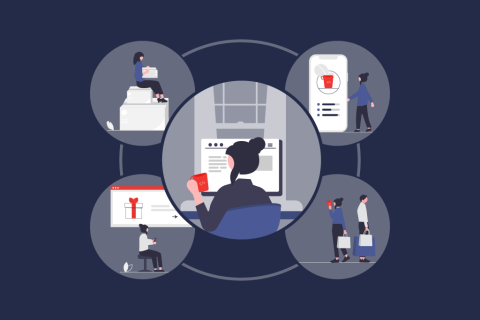Marketing
Customer Experience – Buzzword Bingo or is there more to it?

Content
Why is Customer Experience More Important Than Ever?
The consumer’s expectations of companies and their products is higher than ever – and for a good reason: Online retail is booming, the markets are becoming increasingly more transparent, the availability of products is more convenient than ever, while the price difference is shrinking. As a result, the competition is growing. It’s for this reason that companies can no longer make it with good products and satisfied customers alone. The magic word of today’s corporate success is Customer Experience (CX). This field is the focus of attention of corporate Marketing departments. However, what exactly does the concept of Customer Experience even amount to and how can your company improve it? Find out more on this, as you read on right here.
What is Customer Experience?
Customer experience encompasses the set of all lived experiences by both potential and existing customers of a company or brand, across the various touchpoints (customer–company interfaces) of every phase in the Customer Journey. Every interaction can positively or negatively shape a customer’s view of the company. Those who manage to design a unique Customer Experience in all points of contact and boost the customer’s satisfaction can secure loyal fans in a sustainable manner when it comes to their own products and brand. In itself, the idea sounds quite simple, right? Though, what measures are required for turning satisfied customers into inspired fans?
How do You Turn Customers into Fans?
The customers of today are well-informed. With their smartphone ready to hand, they can get all the information they need on any product or service regardless of time and location. Furthermore, with the emergence of the age of digital transformation, the number of digital touchpoints has also skyrocketed. Here – where personal contact and advice by phone used to be the essential points of contact with customers –, online shops, social media, and e-mail marketing now reign supreme as indispensable measures. For companies, the name of the game is to reach out and inspire consumers across all touchpoints with target-group-oriented information and just the right content for their use cases, hereby also promoting customer loyalty. This is a challenge not to be underestimated, considering that the set of relevant information multiplies with the number of products, be it descriptions, texts, media assets, videos, or product images about said products.
Only those, however, who manage to design a positive customer experience can lay the foundation for sustainable customer retention. Loyal customers don’t only purchase your brand products but do also occupy themselves with your product portfolio both online and offline. They’re happy to share their positive experience with family and friends or via social media channels, hereby posing as valuable and faithful brand ambassadors.
There is hardly any marketing measure which is as effective as positive feedback from satisfied customers and the word-of-mouth advertisement resulting from it. Have you also felt this wow-experience after an all-around wholesome online purchase before? How many people did you tell about your last few positive purchasing experiences? Did you already pay any of these stores another visit? Those who are content with how the purchasing process went are even willing to pay more.
This is why it’s important to take appropriate measures for a cutting-edge customer experience across all points of contact along the whole Customer Journey. Mastering this challenge makes a professional Customer Experience Management (CEM) indispensable.
What is Customer Experience Management?
Successful Customer Experience Management is an integral part of any CRM and brings – staying true to the principle of Customer Centricity – the customer into the focus of attention. In fact, this trend does even go so far in its strife for improving the purchasing experience that many companies do no longer limit themselves to the concept of “customer” and, instead, shift their center of attention to the underlying human being as part of the Human Centricity approach.
With well-defined strategies and measures from the fields of Marketing and Management, Customer Experience is supposed to be controlled through the positive interaction with the respective touchpoints, hereby boosting customer loyalty. The objective of this method is generating a higher return on sales.
To this end, it’s crucial to identify the relevant target groups and their needs (Buyer Persona) as well as to optimize all touchpoints with which customers interact as part of their Customer Journey – all on the basis of the target group’s purchasing behavior. Mapping out both, a Buyer Persona and the Customer Journey, lays the foundation for a successful Customer Experience strategy. In our free whitepaper “From Buyer Persona to Customer Journey,” you will find concrete recommended actions and tips on how your company can put the Buyer Persona into good use. In this context, one thing can already be anticipated in advance: Handling customer-oriented e-commerce by manual work alone is nigh impossible. Yet, there’s no reason to worry whatsoever. There are suitable tools which allow you to automate and optimize processes to guarantee that measures to improve the Customer Experience provided by your company will be a surefire success.
All-In-One with the Right Tools
When operating within the scope of Customer Experience Management, it’s key that all teams across your entire company are working toward a unified Customer Experience in a coordinated fashion. This does also include the consistent use of tools across several departments. Processes should flow and transition smoothly into one another, while information should always be transparent. It’s the right combination of tools and well-defined processes that enables department-overarching CX. A good example for this are Customer Relationship Management systems which allow you to organize the customer information which is otherwise left scattered over several departments.
Depending on the product, touchpoint, target group, and use case, the customer always requires a different set of information. This is why a PIM system (Product Information Management system) is a must-have tool for groundbreaking Product Experience, i.e. the totality of responses during all stages of a customer’s research and purchasing process. The equation is quite simple: no successful Product Experience without top-notch Customer Experience. Make your products more experienceable and intuitive by not only marketing your products but also the underlying values and solutions. With consistent product data as your unshakable foundation, you can quickly collect the right data and descriptions for the right product and even distribute them at the right time to the right target group at the click of a few buttons.
You should only move on to analyze your customer’s demands after establishing this secure basis. This is what will allow you to realize suitable measures and processes for good Customer Experience. For this analysis, in turn, you will need to know what your customers want – here, feedback is the magic word. In principle, customer feedback in any form can be fruitful – be it positive or negative. Once all available feedback has been gathered, you can proceed by evaluating it and render it operative for your Customer Experience Management.
To objectively measure such empirical data, the Net Promoter Score is employed. In short, NPS. This key performance indicator represents a company’s customer satisfaction rate. In general, this score measures how costumers reply to the question: “How likely is it that you will recommend this company?” With the Net Promoter Score, you can find out how loyal customers are to a given company and if they would make use of its products and services again or even recommend it to others. The reply is measured by an evaluation scale form 0 (unlikely) to 10 (extremely likely).
Those who give a rating of 9 or 10 are referred to as promoters. In this case, your hard labor is already bearing fruits and convincing customers. Detractors, on the other hand, are defined as all those customers who give a rating between 0 and 6. Customers who give a rating of 7 or 8 are classified as being indifferent. All in all, you can calculate your own company’s NPS using the following equation:
NPS = Promoters (in percent) minus Detractors (in percent). As a result, possible NPS values range from plus 100 to minus 100.
Customer Experience: More Than Mere Buzzword Bingo
The significance of Customer Experience for companies far exceeds a simple definition which would reduce this complex phenomenon to the field of Marketing alone. Current trends indicate that a positive CX will advance to be a more and more essential factor for purchasing decisions, be it online or offline, be it B2B or B2C. Today’s customers want a simple and quick solution for their challenges. If the Online Marketing strategies or your well-groomed (digital) touchpoints succeed in optimizing the experience customers have while checking out your offers and buying your products, this will positively influence both customer satisfaction and retention. This, in turn, translates into sales and corporate success. Such strategies for improving Customer Experience, however, can only succeed if your entire company looks at things through the customer’s eyes and continues to do so throughout the whole Customer Journey. To make your CX Management strategy click together, all teams need to be on board and live the processes defined.
This also includes the integration of a software solution with which you can not only pool together all marketing-relevant information and assets, but also manage, enrich, and distribute your products in a contextualized manner. This is the basis for your unique Customer Experience. Equipped with this, you can transform satisfied customers into loyal fans of your company, your product, and your brand, while also staying streets ahead of the competition.
We support you on your path toward ideal Customer Experience – with our expertise and our PIM software.
From Our Blog
You may also be interested in the following articles







